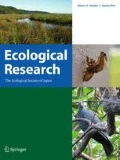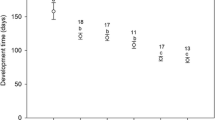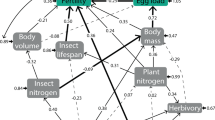We examined the effects of diet mixture on the nymphal performance of a polyphagous grasshopper Parapodisma subastris Huang by developing the first-stadium nymphs with either single or various combinations of plants occurring in their natural habitat. Intrinsic quality in terms of nymphal survival differed largely across the 16 plant species. However, even combinations of the six worst quality plants (survival 10% or less in each) greatly improved nymphal survival when compared to that of superior quality plants (more than 70% survival). In contrast, the addition of either of two inferior plants (more than 10% and less than 40% survival) to the superior plant affected neither the survival nor the adult mass. Thus, diet mixture can be particularly important when only low quality plants are available. The adaptive significance of diet mixture was discussed in relation to the habitat flora and foraging habits of the grasshopper in the present study.
Similar content being viewed by others
References
Bernays E. A., Bright K. L., Gonzalez M. & Angel J. (1994) Dietary mixing in a generalist herbivore: tests of two hypotheses. Ecology 75: 1997–2006.
Bernays E. A. & Chapman R. F. (1994) Host-Plant Selection by Phytophagous Insects. Chapman & Hall, New York.
Bernays E. A. & Minkenberg O. P. J. M. (1997) Insect herbivores: different reasons for being a generalist. Ecology 78: 1157–1169.
Bright K. L., Bernays E. A. & Moran V. C. (1994) Foraging patterns and dietary mixing in the field by the generalist grasshopper Brachystola magna (Orthoptera: Acrididae). Journal of Insect Behavior 7: 779–793.
Chambers P., Sword G., Angel J. E., Behmer S. & Bernays E. A. (1996) Foraging by generalist grasshoppers: two different strategies. Animal Behaviour 52: 155–165.
Dethier V. C. (1954) Evolution of feeding preferences in phytophagous insects. Evolution 8: 33–54.
Ehrlich P. R. & Raven P. H. (1964) Butterflies and plants: a study in coevolution. Evolution 18: 586–608.
Fox L. R. & Morrow P. A. (1981) Specialization: species property or local phenomenon? Science 211: 887–893.
Freeland W. J. & Janzen D. H. (1974) Strategies in herbivory by mammals: the role of plant secondary compounds. American Naturalist 108: 269–289.
Hägele B. F. & Rowell-Rahier M. (1999) Dietary mixing in three generalist herbivores: nutrient complementation or toxin dilution? Oecologia 119: 521–533.
Howard J. J., Raubenheimer D. & Bernays E. A. (1994) Population and individual polyphagy in the grasshopper Taeniopoda eques during natural foraging. Entomologia Experimentalis et Applicata 71: 167–176.
Miyatake Y. & Kanô Y. (1992) Semi Batta. Hoikusha, Osaka.
Pulliam H. R. (1975) Diet optimization with nutrient constraints. American Naturalist 109: 765–768.
Raubenheimer D. & Bernays E. A. (1993) Patterns of feeding in the polyphagous grasshopper Taeniopoda eques: a field study. Animal Behaviour 45: 153–167.
SAS Institute (2000) JMP® User’s Guide, Ver 4.0. SAS Institute Inc, Cary, NC.
Singer M. S. (2001) Determinants of polyphagy by a woolly bear caterpillar: a test of the physiological efficiency hypothesis. Oikos 93: 194–204.
Westoby M. (1978) What are the biological bases of varied diets? American Naturalist 112: 627–631.
Zar J. H. (1999) Biostatistical Analysis, 4th edn. Prentice Hall Inc, New Jersey.
Author information
Authors and Affiliations
Corresponding author
About this article
Cite this article
MIURA, K., OHSAKI, N. Diet mixing and its effect on polyphagous grasshopper nymphs. Ecol Res 19, 269–274 (2004). https://doi.org/10.1111/j.1440-1703.2004.00635.x
Received:
Accepted:
Issue Date:
DOI: https://doi.org/10.1111/j.1440-1703.2004.00635.x




